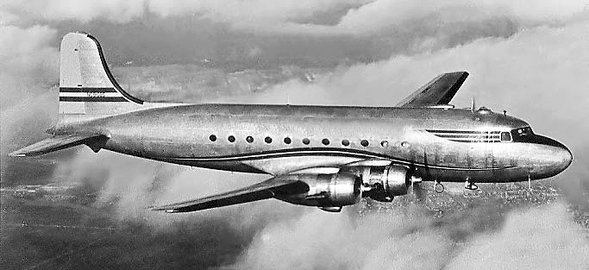Douglas DC-4 Incident Report (June 2009)

Not the aircraft involved in the incident
This remarkable incident took place back in the 50s over one of the USA’s south-western states. A Douglas DC-4 was en-route and the passengers were settling down to enjoy some light in-flight refreshment. In the cockpit was an extra crew member, a pilot who was qualified on DC-4s and was on board for ‘route-familiarisation’. He was occupying the jockey-seat, a folding chair immediately behind the captain’s seat.
The captain turned and asked him if he would like to change seats and take over. Now in the jockey-seat, the captain watched the scenery for a while - but he’d flown over this desert many times. His bored gaze wandered around the cockpit. Then he noticed, by his feet, the control locking levers. These are applied when the aircraft is parked on the ground and are intended to prevent damage to the control surfaces if a gust of wind blew them against the stops. ‘I wonder if they’ll notice if I put the locks on’ he mused. No sooner thought than actioned and he bent down and pulled the levers into the lock position.
At the time the DC-4 was a little tail-heavy so forward trim had been applied. This raises the trim-tab on the trailing edge of the elevator, forcing the elevator down slightly and providing the extra lift to balance the tail-heaviness. But when the control locks were put on the elevator was lifted to the neutral position and so the aeroplane began a gentle climb. The pilot in the captain’s seat noticed this and reached for the trim wheel, rolling it forwards. This raised the trim tab but, now that the elevator was locked in neutral its effect was only to increase the rate of climb. More rolling of the trim wheel made things even worse.
At this point, the captain (in the jockey seat) realized that things were getting out of hand. Giving no warning to the others about what he’d done he scrambled down by his feet to unlock the controls. By this time the trim tab was fully raised so when the elevator was released it slammed hard down. The DC-4’s nose went smartly down into the first stage of an outside loop. Everyone felt the effect of negative g. Manuals, loose equipment, coffee cups and two unstrapped pilots rose rapidly to the ceiling. In the process, the panel holding the airscrew feathering buttons was struck and three of the four propellers feathered.
In a few seconds the airliner had gone from cruise to inverted flight with only one effective engine providing thrust. Fortunately, the second pilot had not unstrapped. He recovered sufficiently from his surprise to roll the aircraft level. It was flown, carefully, to the nearest airfield and landed.
The report did not specify the state of affairs in the passenger cabin. The aircraft, however, now the world’s only aerobatic DC-4, was a complete write-off.
The captain promptly ‘left the services of the airline’.
The captain turned and asked him if he would like to change seats and take over. Now in the jockey-seat, the captain watched the scenery for a while - but he’d flown over this desert many times. His bored gaze wandered around the cockpit. Then he noticed, by his feet, the control locking levers. These are applied when the aircraft is parked on the ground and are intended to prevent damage to the control surfaces if a gust of wind blew them against the stops. ‘I wonder if they’ll notice if I put the locks on’ he mused. No sooner thought than actioned and he bent down and pulled the levers into the lock position.
At the time the DC-4 was a little tail-heavy so forward trim had been applied. This raises the trim-tab on the trailing edge of the elevator, forcing the elevator down slightly and providing the extra lift to balance the tail-heaviness. But when the control locks were put on the elevator was lifted to the neutral position and so the aeroplane began a gentle climb. The pilot in the captain’s seat noticed this and reached for the trim wheel, rolling it forwards. This raised the trim tab but, now that the elevator was locked in neutral its effect was only to increase the rate of climb. More rolling of the trim wheel made things even worse.
At this point, the captain (in the jockey seat) realized that things were getting out of hand. Giving no warning to the others about what he’d done he scrambled down by his feet to unlock the controls. By this time the trim tab was fully raised so when the elevator was released it slammed hard down. The DC-4’s nose went smartly down into the first stage of an outside loop. Everyone felt the effect of negative g. Manuals, loose equipment, coffee cups and two unstrapped pilots rose rapidly to the ceiling. In the process, the panel holding the airscrew feathering buttons was struck and three of the four propellers feathered.
In a few seconds the airliner had gone from cruise to inverted flight with only one effective engine providing thrust. Fortunately, the second pilot had not unstrapped. He recovered sufficiently from his surprise to roll the aircraft level. It was flown, carefully, to the nearest airfield and landed.
The report did not specify the state of affairs in the passenger cabin. The aircraft, however, now the world’s only aerobatic DC-4, was a complete write-off.
The captain promptly ‘left the services of the airline’.